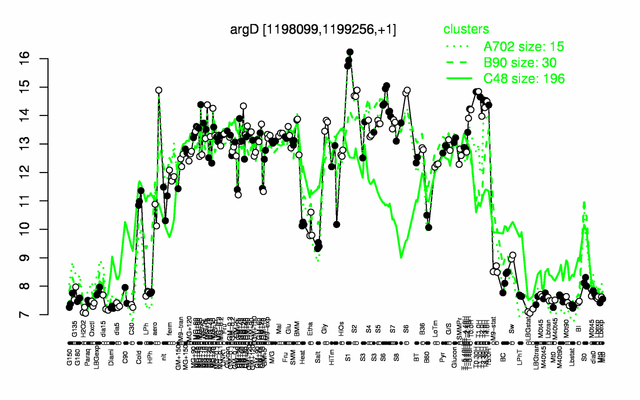ArgD
Revision as of 13:53, 17 April 2014 by 134.76.70.252 (talk)
- Description: acetylornithine transaminase
| Gene name | argD |
| Synonyms | |
| Essential | no |
| Product | acetylornithine transaminase |
| Function | biosynthesis of arginine |
| Gene expression levels in SubtiExpress: argD | |
| Metabolic function and regulation of this protein in SubtiPathways: argD | |
| MW, pI | 40 kDa, 5.929 |
| Gene length, protein length | 1155 bp, 385 aa |
| Immediate neighbours | argB, carA |
| Sequences | Protein DNA DNA_with_flanks |
Genetic context 
This image was kindly provided by SubtiList
| |
Expression at a glance PubMed
| |
Contents
Categories containing this gene/protein
biosynthesis/ acquisition of amino acids
This gene is a member of the following regulons
The gene
Basic information
- Locus tag: BSU11220
Phenotypes of a mutant
Database entries
- BsubCyc: BSU11220
- DBTBS entry: [1]
- SubtiList entry: [2]
Additional information
The protein
Basic information/ Evolution
- Catalyzed reaction/ biological activity: N(2)-acetyl-L-ornithine + 2-oxoglutarate = N-acetyl-L-glutamate 5-semialdehyde + L-glutamate (according to Swiss-Prot)
- Protein family: ArgD subfamily (according to Swiss-Prot)
- Paralogous protein(s):
Extended information on the protein
- Kinetic information:
- Domains:
- Modification:
- Cofactor(s):
- Effectors of protein activity:
- Localization: cytoplasm (according to Swiss-Prot)
Database entries
- BsubCyc: BSU11220
- Structure:
- UniProt: P36839
- KEGG entry: [3]
- E.C. number: 2.6.1.11
Additional information
Expression and regulation
- Additional information:
- number of protein molecules per cell (minimal medium with glucose and ammonium, exponential phase): 1476 PubMed
- number of protein molecules per cell (minimal medium with glucose and ammonium, early stationary phase after glucose exhaustion): 850 PubMed
- number of protein molecules per cell (minimal medium with glucose and ammonium, late stationary phase after glucose exhaustion): 1501 PubMed
Biological materials
- Mutant:
- Expression vector:
- lacZ fusion:
- GFP fusion:
- two-hybrid system:
- Antibody:
Labs working on this gene/protein
Your additional remarks
References